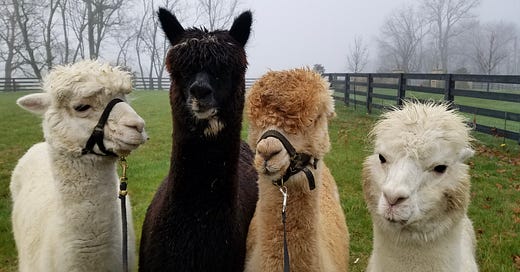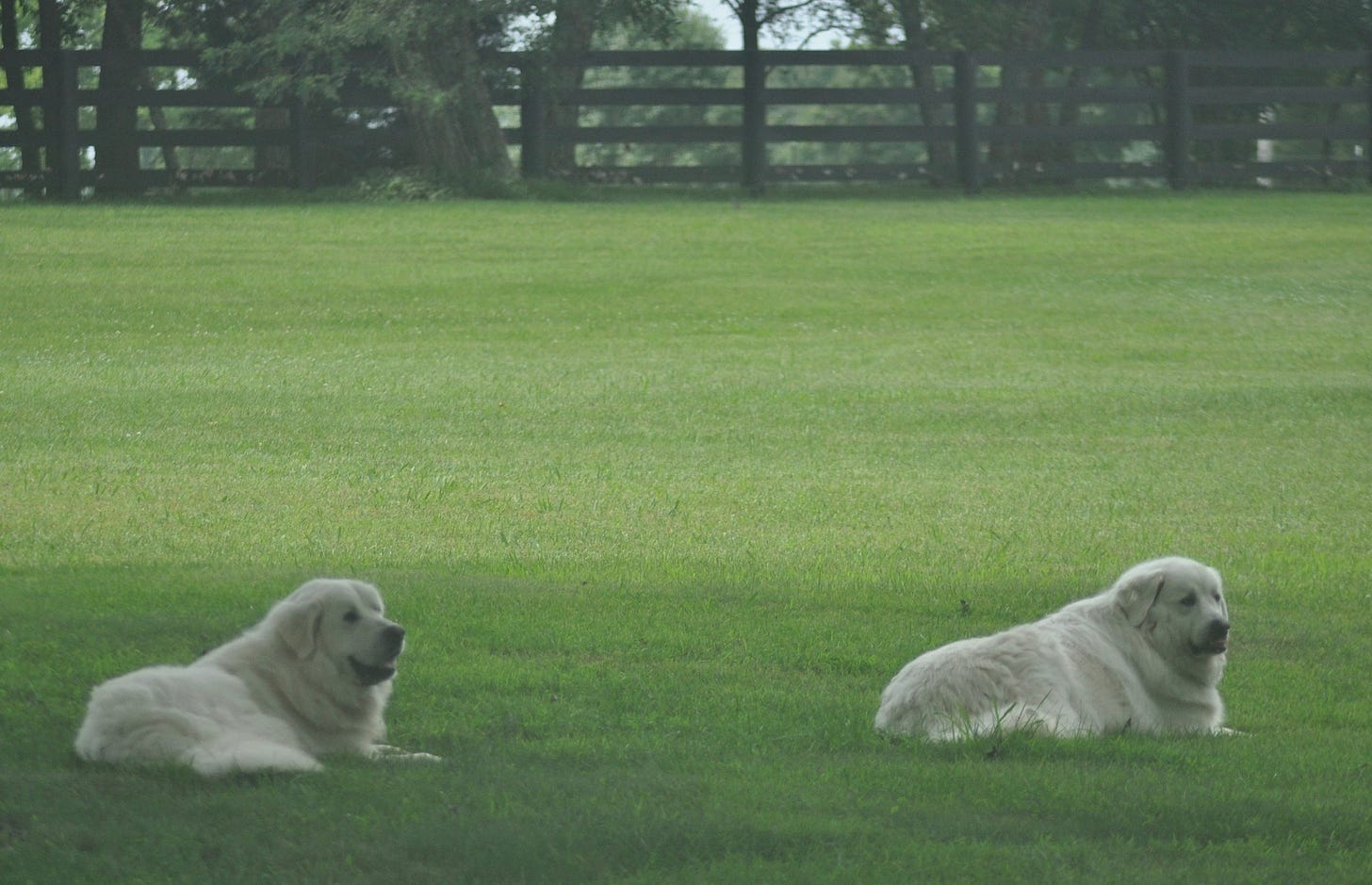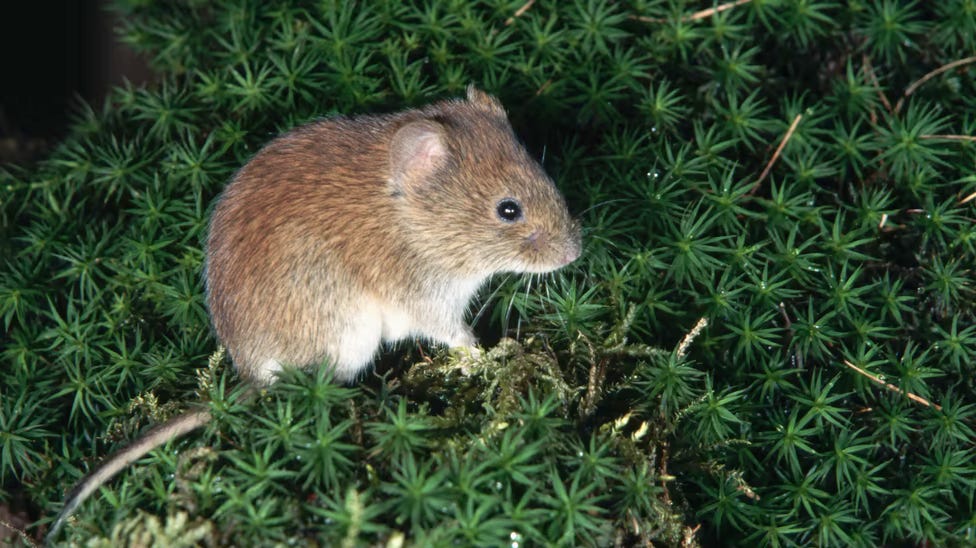Refugia Newsletter #58
2023 in review, mangroves, voles, conservation gains, disinformation sources, and singing about joy
Refugia News
Happy new year! I hope you enter this new year amid a community of grace and resilience—family, friends, faith community. May we lean into courage and intentional joy, whatever this new year brings.
I’m beginning the year with two blessed weeks of preparation work at home before spring semester begins. One of the projects I’m working on is rewriting my university’s “Statement on Sustainability.” Our current one was written in 2007 and needs updating. Since our university-wide sustainability work has accelerated admirably since 2007, I’m excited to celebrate that work and honor new goals with a fresh document.
However: yikes. I volunteered for this job thinking (foolishly) it would be mostly a read-stuff-and-write-stuff task, which I love. But now I realize it’s also an interviews-and-diplomacy task that will take a year or more, as I work to make the process as collaborative as possible across the institution. What have I gotten myself into??? Help!
If you have been involved in working on such a statement, especially in the higher education realm, would you please send me a note with any words of advice or helpful, comparable statements? (You can just reply to this newsletter.) Thanks!
Here’s some exciting news from the ongoing Rienstra Household Electrification Project: we put in a heat pump! Yes! We hadn’t been planning to do it until later this year, but rebate this and year-end-special-deal that—and here we are. Plus IRA tax credits, of course. So far so good! The house is warm and we have a spiffy new smart thermostat, too. With app!
Here’s the indoor part. This is an air-source heat pump system with backup furnace (sigh, but…), fitted into our existing duct work.
Finally, a fond shout-out to reader Jerry Cappel of the Center for Deep Green Faith in Kentucky. Jerry garnered five new readers for this newsletter through the Substack referral button, so he is hereby rewarded by featuring his beloved pet photos below! Thanks, Jerry. I’m jealous of all these furry critters. I mean: alpacas!! and giant, fuzzy dogs!
“The girls” on a spring morning at Cappelhurst. L to R: Camryn, Rya, Savannah, and Tinkerbelle.
And of course, we need dogs on duty, too: Ainsley and Emma.
This Week in Climate News
Reading the end-of-year climate news summaries was an exercise in “best of times, worst of times,” which is pretty much how the Distilled newsletter summed it up:
It’s no contradiction to say that 2023 was both one of the worst years for our climate future and one of the best, a year full of reasons to despair and one full of signs of hope.
In scary news, it was the hottest year in 125,000 years. Here’s a fun graphic from the New York Times showing just the last century-plus:
Monthly global temperature compared with average for the 20th century
From New York Times. Source: NOAA. Note: Monthly temperature anomalies for global land and ocean are relative to 1901-2000 averages. Data available through November 2023.
Also on the bad side of the ledger: Canadian wildfires, record flooding, continued increase in fossil fuel emissions, proposed fossil fuel projects, melting Arctic ice—all the usual things. We’re still, at the moment, on track to warm by 2.8C by 2100. Not OK.
However, it was also a year of landmark legislation, huge clean-energy build-outs and infrastructure advancement, battery innovation, sharp increases in EV sales, record investments in clean energy, progress on international cooperation and climate finance, and a projected fall in emissions soon.
Volkswagon is introducing an all-electric retro-bus later this year. How cool is that? They are calling it, inexplicably, the “VW ID. Buzz.”
Will the pace of progress overmatch the pace of climate impacts? Well, that’s always the question. It’s a race. For three great summaries of the year’s news, I recommend this article by the Inside Climate news staff, and this one by Michael Thomas and Nicole Pollack of Distilled, and this one from the Grist newsletter, The Beacon.
Workin’ with the critters. Let’s celebrate one good news aspect of the 2023: progress with conservation. Conservation isn’t quite the right word anymore, actually. That’s an older term that seems to imply “keeping ecosystems the same and banning human interference.” But that’s not really what we need to do. Humans have always altered ecosystems, for good and for ill. We are now simply more numerous and powerful than ever before in history. As I say in Refugia Faith, our goal is not “stewardship” (in the sense of wise use) or “preservation.” Our human role is better described now as “partners in earth healing.” Often enough, that means allowing and promoting the earth’s self-healing properties.
So it’s good to see many, many, many good news stories about land and water protections, biodiversity gains, Indigenous leaders at the center of policy and care, urban greening projects, regenerative agriculture, and improved understanding of just how crucial plants, soils, and animals are to health for all life on the planet—including humans’.
This article by Bob Berwyn of Inside Climate News sums up how the recent COP28 gave some good attention to the urgent importance of working with rather than against nonhuman creatures:
Nature is humanity’s biggest ally in the struggle to limit global warming. Forests, oceans and fields absorb and store about half the annual heat-trapping carbon dioxide pollution from burning oil and gas and other industrial and agricultural activities. The final COP28 statements prominently emphasized the importance of nature, and not just forests.
A joint COP28 statement on nature, climate and people said there is no path to the goal of limiting warming to 1.5 degrees Celsius “without urgently addressing climate change, biodiversity loss and land degradation together in a coherent, synergetic and holistic manner, in accordance with the best available science.”
Also on the big picture scale, the 2022 Biodiversity Summit resulted in hopeful commitments:
The final deal, reached in the early hours of Monday 19 December, included the oft-repeated headline target of “30×30”—an ambition to conserve 30% of the world’s land and 30% of the ocean by 2030.
(Another summit will be held in October of this year.) However, these big global agreements are, in a way, less interesting than all the local actions happening.
Rainforest deforestation, for instance, has declined markedly in the last year in Brazil (56%), Colombia (67%), and Peru (37%), thanks to the leadership of new presidents and the persistent work of activists and Indigenous people.
In the US, we’re tussling over protecting wildlife corridors, which would make life easier for creatures like these pronghorn antelope in Wyoming. Credit: Joel Berger for Inside Climate News.
People are working hard in Indonesia to plant mangroves in order to restore key coastal ecosystems. A couple in Mexico has taken on mangrove restoration as their personal mission. These are just a few of thousands of other good stories, including how Papua New Guinea has tripled their critical marine protected area, and Rwandans are planting trees near hospitals.
Even little voles in Alaska are getting some love, as scientists study how they helpfully engineer the tundra so that it keeps breathing in carbon.
Also, voles are adorable. Credit: Naturfoto Honal/Getty/The Atlantic
If you want a regular dose of good nature news, I recommend the Future Crunch newsletter.
Deeper Dive
Now to explore some nefarious underworlds. Climate disinformation and misinformation (they’re different things) make shifting public opinion and getting everyone on board with climate action extremely difficult. If you’ve ever found yourself in an argument with a friend or relative over climate change, you know how this goes.
I’ve written about disinformation/misinformation before, especially in newsletter #49. I bring it up again here because of this very interesting report, “Deny, Deceive, Delay,” released just before COP28, from a global partnership group called Climate Action Against Disinformation.
Here’s the big-picture summary:
This report, the third in a series by CAAD partners, offers a window into three distinct ecosystems engaged in climate mis- and disinformation: the fossil fuel lobby; State-affiliated actors; and those profiting form the ‘outrage economy’ online. To a greater or lesser extent, all participate in and amplify the narratives outlined above [basically, delaying decarbonization and sowing division to undermine democracy], and serve to benefit from their proliferation. [emphasis original]
Even that basic taxonomy of three “ecosystems” is helpful, but I found the whole report explanatory in tracing how bad information makes its way from powerful interests to average people.
If you want further gruesome details of this whole nefarious underworld, I recommend this nine-part series from Inside Climate News. Just the first installment was enough to make my students pretty mad last semester.
If you need some handy ways of responding to various climate dis- and misinformation, you might try Katherine Hayhoe’s Global Weirding YouTube channel or the Grist myth-busting page. Any other good resources you would recommend?
Refugia Sighting
Is your faith community a refugium? As many faith groups seek to engage meaningfully with the climate crisis, drawing from the resources of their traditions, might there be a role for… an election sermon to start off the year?
I know, it sounds terrifying. “Run away!” you might be thinking, especially if you are a clergyperson yourself. However, over on the Third Act Faith group’s Substack, the indefatiguable Rev. Jim Antal makes a pretty good case for an election sermon, with some pointers for doing it well.
It’s not about being partisan, he assures. But it is about urging adherents to use their particular strengths as people of faith in their communities:
When it comes to addressing the crisis of democracy as well as the climate emergency, what we need to do is reach the human heart. That’s exactly what congregations, clergy and people of faith are good at. Throughout history, driven by a desire to be faithful to God, people of faith have called upon their gifts, their abilities and their soul-force to address many of the failures of our public life. Engaging public life is as important as any purpose of the church, the synagogue or the mosque.
Antal outlines four moral principles for analyzing candidates, principles the preacher can emphasize in the sermon: caring for the least of these, justice, integrity of creation, and means/ends. “With very little editing,” Antal observes, “clergy from any faith tradition could make these principles the core of their election sermon and support each principle with scripture from their tradition.”
What do you think? Would that fly at your house of worship? If you’re a clergyperson still trembling at the thought of this, you might consider reading Dr. Leah Schade’s excellent Preaching in the Purple Zone. Good luck!
Or here’s another possible resolution for 2024: encourage your faith group to become a refugium by emphasizing the practice of joy. For some inspiration, you might watch this TED talk from Ayana Elizabeth Johnson, “How to Find Joy in Climate Action.”
The Not-So-Wayback Machine
Speaking of joy, happy Feast of Epiphany today! Epiphany means “divine revealing” and in the Christian liturgical year, it’s the time where Christians commemorate the visitation of the Magi to the Christ child. Then, for the next several weeks, we reflect on the life and ministry of Christ. Epiphany emphasizes light—the light of God in the world.
So I thought I would share with you this recording of a work composed by Sean Ivory and performed by the Calvin [University] Alumni Choir at their Christmas concert on December 8. The piece is called “Christe Lux Mundi”: Christ, light of the world. That’s Sean conducting. And if you look very closely, you can see me playing my viola! I think the second movement is especially gorgeous. I hope this brings some light.
Thanks for reading. It’s good to begin a new year with you. Until next time, be well.
(As always, all bold emphasis in quotations is added unless otherwise indicated.)











I had to stop reading your newsletter to read all about the new VW microbus. It's in our sights now as a next car. We figure once the kids are grown we can revamp it into a sleeper van for my husband and I to drive around the world. :-) And, yes, strange name that includes caps and punctuation.